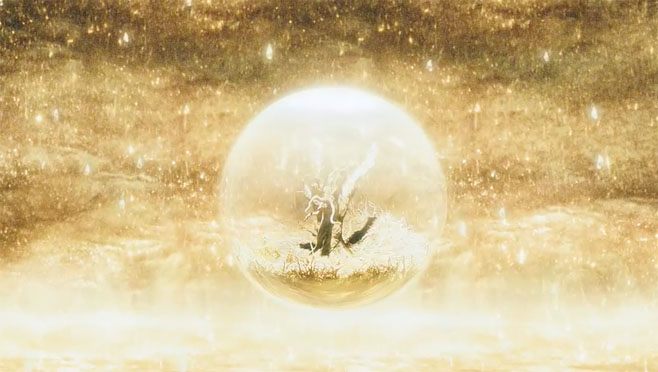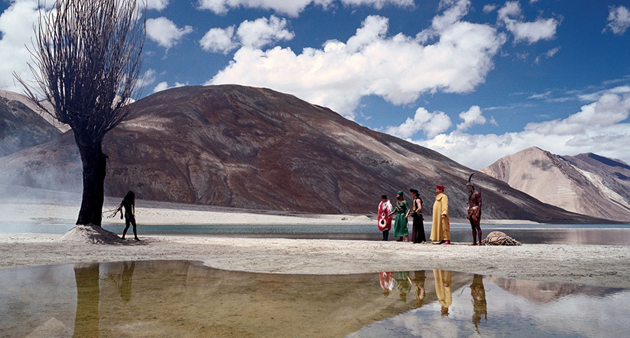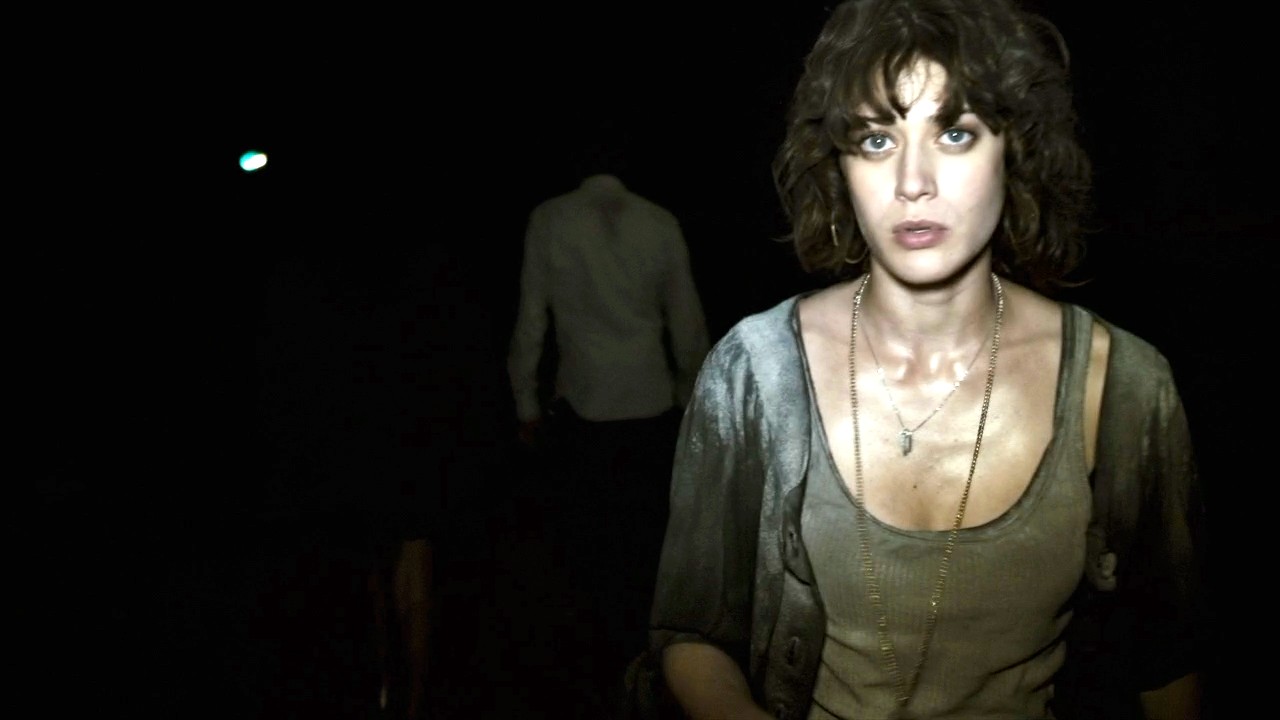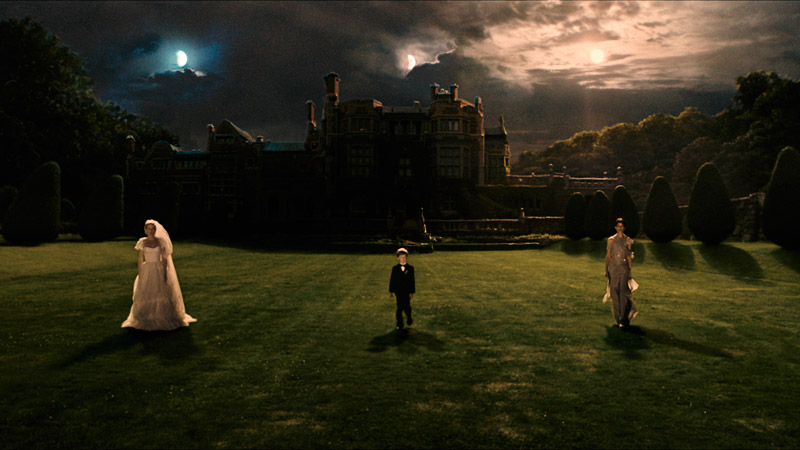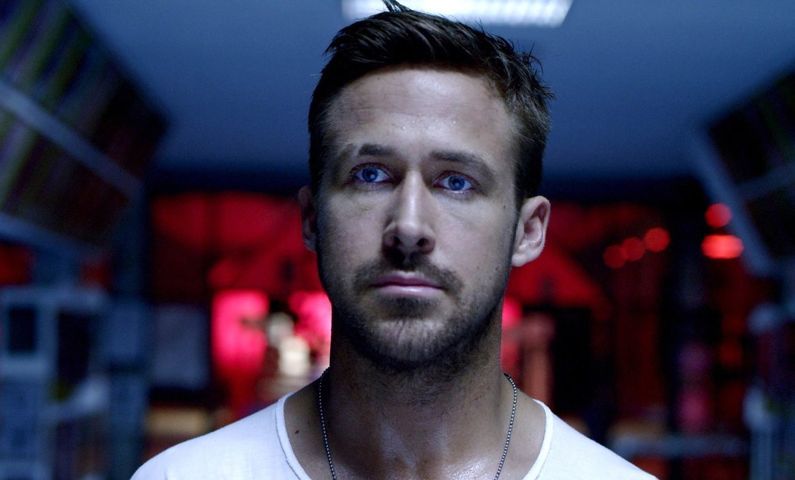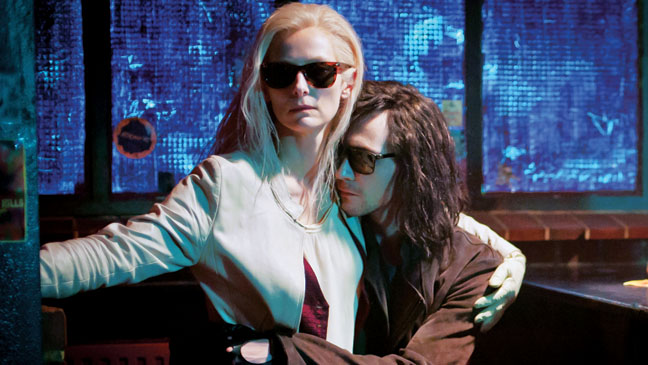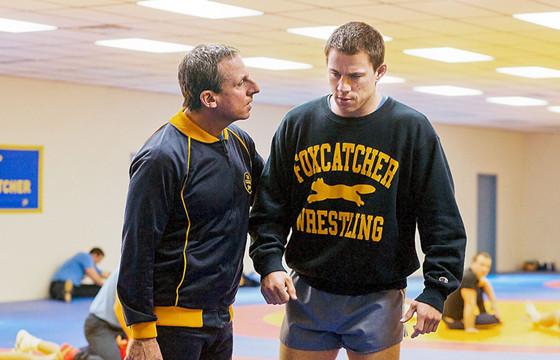14. The Fountain (Darren Aronofsky, 2006)
Cinematographer Matthew Libatique is an exceptional DP by any standard, and this film is some of the best evidence to support that assertion. As a classmate of Aronofsky’s in the same NY film school, Libatique has come up with director and their styles have undoubtedly influenced the other’s.
In interviews, they have said that Libatique is mostly responsible for the lighting, Aronofsky for the framing and camera movement. Having worked on big dollar productions like ‘Iron Man’, Libatique has stated that he will work with Aronofsky when possible (and he has lensed everything by that director except for ‘The Wrestler’) as he provides him with the greatest creative challenge. Although he feels that ‘Requiem for a Dream’ might be their greatest collaboration, he understands how the director might place ‘The Fountain’ at the top of the list.
In what is essentially ‘Love Story’ through a prism that splits the story into three separate but intertwined historical threads: Inquisition-era Spain and a tale of Queen and beloved explorer, the present with its brain-research specialist and his dying wife, and the far future where a man heads towards his death in a far-flung constellation.
All three couples are played by the same pair of actors, Hugh Jackman and Rachel Weisz, and the lighting spans the spectrum to describe their various worlds: outdoor shots, sometimes in the harsh glare of the sun reflected from the snow (Libatique says he rarely supplements natural light, except to reflect some onto the surroundings or the actors’ face), interiors in a variety of settings (church, castle, and dungeon in Spain, the hospital, lab and home in the present, and within a glowing golden sphere that travels through space).
Many of the shots, particularly at the beginning at the foot of the Mayan temple, are filmed in near total darkness, gorgeously skating that line at the edge of visibility. Most of the scenes from the present that take place in their home are suffused with a soft, low light, a technique that adds a somber feeling to those scenes and implies the fading of Izzy’s (Rachel Weisz) life.
The futuristic set was rendered against a micro-photographed background involving solutions in a Petri dish, Aronofsky having foregone any CGI so as to maintain a more timeless look, and it’s rich gold and bronze hues often light the pair within their bubble. Perhaps the most strikingly lit scene is one wherein Rachel Weisz, playing the Spanish queen, tasks Tomas (Hugh Jackman) with searching for the Tree of Life: she glows radiantly, bathed in a bright light that gives her the appearance of a vision, the look of an angel. It would be hard to think of a single shot that shows her beauty off to better advantage.
15. The Fall (Tarsem Singh, 2006)
Known as much for his striking compositions as his tendency towards the fantastic in scripts, few director’s have made outdoor landscapes seem so gargantuan or so surreal. Filmed in more than twenty countries over a period of four years, cinematographer Colin Watkinson (a camera loader promoted to cameraman by Singh for this film!) captures a number of stunning shots, most of them wide-angle and all on 35mm film.
Like ‘The Adventures of Robin Hood’ 70 years previous, ‘The Fall’ celebrates the vibrancy of colors brought to life by sunlight. Roger Ebert, who included ‘The Fall’ among his 20 Best of 2008, said “You might want to see for no other reason than because it exists. There will never be another like it.”
A simple storyline about a girl with a broken arm and a depressed, bedridden stuntman who become friends while recuperating in a hospital, most of the film takes place outdoors in large, open spaces or interiors like hospital room, which are lit by the daytime sun pouring through the windows. Though the colors are strong, it’s that part of the movie that illustrates the fantastical tale the man weaves for her day-to-day where the hues become electric.
Again, like ‘Robin Hood’, a preponderance of primary colors (especially reds, greens and blues) keep the compositions simple and striking. It is easy to believe that Tarsem Singh financed the film out of his own pocket in order to realize his singular vision in an unadulterated fashion.
More a work of art to be enjoyed for its own sake than a traditional tale heavy with the gravitas of traditional storytelling, Singh’s film celebrates the singular joy of light and vision and confirms Roger Ebert’s declaration that there may never be another like it.
16. Cloverfield (Matt Reeves, 2008)
Perhaps the most engaging and cathartic of any post-9/11 film, Matt Reeve’s ‘Cloverfield’ is a tale of a giant creature laying waste to NYC, recorded by one handheld camera. Rather than seeming amateurish and/or overly hipster, the camerawork gives a sense of urgency and tension to this short (80 minutes, the length of a mini-DV cassette) record of a city’s destruction.
In spite of some elements that seem less than realistic (an impossibly long charge for a single battery, a non-consumer camera range of exposures), and cinematographer Michael Bonvillian occasionally tipping his hand through stylized camerawork, the suspension of disbelief is maintained through the film’s short length, the tightly edited, no fat storytelling, and the lighting.
To wit: at the start of ‘Cloverfield’ all is happiness and light: from our star-crossed lovers awakening in a highrise condo to a cheerful cityscape below them, to the high exposure going away party scenes, things seem hopeful for all involved. Once the destruction begins, however, its low exposure conveys a sense of doom and uncertainty. The bits of Coney Island footage (that record being taped over, at first by accident, later by necessity) that pepper and end the rest of the movie only serve to highlight the difference between now and then.
Cloverfield aims for that feel of realism and to this end very little of the lighting looks overly professional. One of the tensest scenes, in a film chock full of them, is where our bedraggled group of survivors are traveling through a subway tunnel. Hearing some unrecognizable and threatening sounds, they extinguish their flashlights and the camera switches to infrared mode. In the greenish, eye-reflecting light the subway ceiling is revealed to be covered with swarms of alien lice (smaller, deadly critters that fall from the body of the giant monster).
Another in that series of frightening films that occur in the span of one night, the dawning light that greets our two survivors before the Army puts the hammer down and bombs the island makes this scene particularly poignant, especially when it is contrasted with the final, sunny scene of the original, taped-over date footage from Coney Island.
17. Melancholia (Lars von Trier, 2011)
‘Melancholia’ is the second film in Lars von Trier’s Depression Trilogy and, though written under the influence, is as openly poetic as any of the director’s other work. Combining Dogme rules with certain classical elements of his earlier works, von Trier turns all the apparent paradoxes and gaps in the narrative into a strangely uplifting and unified whole.
The film is roughly broken into two parts, the first half mostly interior shots of the wedding reception for Justine (Kirsten Dunst) and John (Kiefer Sutherland) and daytime exteriors, the second half concerned with the imminent collision with Melancholia and taking place on the grounds of the estate at night. Both halves are bookended by CGI renderings of the approach and collision of Melancholia with the Earth.
Cinematographer Manuel Alberto Claro has stated that “We used very yellow lights for the wedding. The idea was to create an environment that was somehow too happy—happy to the point that it becomes disturbing. The yellowness of the lighting is too much; it starts to seem nauseating.”
The lighting of this section of the film also calls to mind the sickly light of a dying sun, brighter than usual but signifying a nova-like, end-of-life stage for this star (and our world), a symbol for the end of our existence in this universe, a contrast to the sunny and cheerfully lit exteriors, blithely unreflecting the pending apocalypse.
As befits a film dealing with the impending and unavoidable destruction of the planet, much of the second half takes place at night, and here again lighting is key to setting the mood. Describing the color scheme as “…much more neutral. I would almost call it Protestant…”, Claro helps navigate the plot into a more surreal and dreamlike place. Combined with painting-like tableau rendered by the ultra high-speed Phantom camera, the film becomes almost an anti-action film, the opposite of the usual loud and visually busy style of those movies concerned with the annihilation of our planet.
18. Only God Forgives (Nicholas Winding Refn, 2013)
Mostly filmed at night or in dusky club interiors, with a dim dawn or two thrown into the mix, Nicholas Winding Refn’s Thailand is lit like many Asian films, with electric reds and blues dominating the night’s palette. Cinematographer Larry Smith’s (‘Eyes Wide Shut’) lighting is almost universally praised in a film that was just as often panned by the same critics.
When the main character, Julian (played by Refn favorite Ryan Gosling) has only seventeen lines of dialogue, visuals become the main method of telling the story. To Smith’s credit, even though it was shot digitally, the film appears as lush as any 35mm film and the various tableau are as striking and evocative as any film released in 2013.
The plot concerns the execution of Julian’s pedophile brother by Chang, a police chief with a wicked sword arm and fondness for karaoke, and the resulting arrival of his cruel and manipulative mother (Kristen Scott Thomas) to seek vengeance. The dynamics of this hugely dysfunctional mother and child relationship determine the particular spiral to Hell these two will travel.
Refn has stated that he felt there was a distinct difference between Bangkok by day and that same city at night. The bright, almost carnival-esque lighting remains, but its utilization as an accessory to a Disneyland environment by day changes to an ironic beautification of that dark and sinister world after sunset.
Many times Gosling is filmed in a crimson, blood-tinged light, signifying his existence in a purgatory of sorts, doomed by genetics to suffer an unhappy life, whereas his mother is often surrounded by multi-colored neon like some queen of this electric underworld, quite at home with the darker side of life.
For those looking for a predictable story arc for either character (Chang’s character remaining much the same quiet avenger throughout), the lack of verbal exposition may be offputting, but for those who willing to meet the director halfway and see these beautifully lit set pieces as more than shallow ornamentation, but as images of the characters’ mindset, the film conveys it meaning so clearly as to be nearly undeniable.
19. Only Lovers Left Alive ( Jim Jarmusch, 2014)
In spite of utilizing a new cinematographer, Yorick La Saux, and shooting digitally for the first time, Jim Jarmusch mainstains his idiosyncratic look, of which lighting is a major element. The film tells the story of a recent chapter in the life of two long lived vampire lovers named Adam and Eve.
A thumbnail sketch of the plot would be the salvation of the dark and moody Adam, an almost suicidal musician and resident of Detroit, by the much more upbeat and brighter bookworm Eve, who lives in Tangiers. In spite of not shooting on film, these scenes have a very appealing and film-like warmth.
In interviews, La Saux has stated that many shots involve a layering of history, from the ancient to the modern, and the lighting is one of the tools to delineate this idea. Whenever we see Adam, in fact, whenever the film is set in Detroit, it is the darkest of nights, near pitch with the set design presenting a disheveled and decaying environment, with most of the technology no more recent than the late 1960’s. Adam is losing hope and the will to live and this is echoed by his surroundings. Often his character is light in half-shadows, much as his hairstyle covers half his face.
In contrast, Eve lives in Tangiers, a place also filmed at night (they are vampires, after all) but lit by the warmest of earthtones. In line with this contrast, her hair is pulled back and her apartment, though cluttered, is brightly lit and its messiness shows us she is active and as full of life as one of the undead can be. She is also quite comfortable with modern technology, as witnessed by one of the opening scenes where she has a video conversation via her iPhone and its brightly backlit screen, whereas Adam uses a much older homemade rig using a TV with its dimmercathode ray tube.
The layering La Saux refers to is present in all these shots, especially when both characters are present. An example would be the death of Marlowe (John Hurt), beautifully composed and lit like a painting by Caravaggio, one of the more moving scenes and certainly one of the most striking.
20. Foxcatcher ( Bennett Miller, 2014)
The first impression one gets is that this is a poorly lit film, underlit to a noticeable degree. Whether it’s an exterior shot of John du Pont’s (Steve Carrell) estate, the interior in Mark Schultz’s room (Channing Tatum), or the gloomiest gym ever, the sense of unease is constant and unrelenting.
A slowly accelerating tragedy about a younger brother eager to please his older brother, both of them competition wrestlers, and how an obscenely rich single man with mother issues attempts to create a competitive team built around them.
It’s only after seeing the single, brightly lit scene of Channing Tatum’s character driving down the highway, hopeful about his future, that it becomes apparent that the lighting is a direct expression of the character’s mindset. A simple idea used to powerful effect, the final irony of daylight illuminating the brutal climax drives the point home with the surety of a nailgun.
